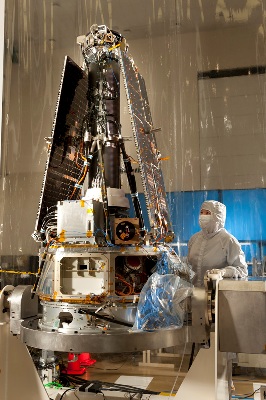Jun 29 2013
Scientists will soon be able to observe the sun like never before, thanks to the successful launch of the Interface Region Imaging Spectrograph (IRIS) spacecraft and science instrument, designed and built by Lockheed Martin for NASA. The IRIS spacecraft was launched at 7:27 pm PDT. IRIS ground stations received telemetry and verified the health of the spacecraft at 8:25 pm PDT.
 Interface Region Imaging Spectograph (IRIS) satellite in Lockheed Martin Space Systems Company in Sunnyvale, Calif., with the solar telescope and bus structure fully integrated.
Interface Region Imaging Spectograph (IRIS) satellite in Lockheed Martin Space Systems Company in Sunnyvale, Calif., with the solar telescope and bus structure fully integrated.
The launch has long-term implications for understanding the genesis of solar storms and the potentially destructive effects they can have on space- and Earth-based technologies, as IRIS will enable scientists to study and model an area of the sun previously beyond our capabilities. By tracing the flow of energy and plasma through a region of the sun between the solar surface and the solar corona, (a region where most of the sun’s ultraviolet emissions are generated, known as the interface region,) IRIS will enhance scientists’ ability to forecast weather in space, which can disable satellites, cause power grid failures and disrupt GPS services. IRIS will deliver near continuous solar observations throughout its two-year mission.
“With IRIS, we now have a unique opportunity to provide significant missing pieces in our understanding of energy transport on the sun,” said Dr. Alan Title, IRIS principal investigator and physicist at the Lockheed Martin Advanced Technology Center (ATC) Solar and Astrophysics Laboratory in Palo Alto, Calif. “The complex processes and enormous contrasts of density, temperature and magnetic field within this interface region require instrument and modeling capabilities that are now finally within reach.”
“The IRIS spacecraft and instrument are emblematic of the wide range of capabilities that Lockheed Martin brings to the exploration and utilization of space,” said Dr. Kenneth Washington, vice president of the ATC. “IRIS is the latest in a five decade heritage of sensing payloads which, cumulatively, have operated for over 800 years in space. Moreover, our small satellite capabilities have supported multiple successful missions including IKONOS, Lunar Prospector, IMAGE, and now IRIS.”
The IRIS mission is a function of NASA’s Small Explorers program, which delivers space exploration missions costing less than $120 million. The program was developed with support from Lockheed Martin’s Civil Space line of business, as well as partners Smithsonian Astrophysical Observatory, Montana State University, Stanford University and the University of Oslo.
LMSSC, a major operating unit of Lockheed Martin Corporation, designs, develops, tests, manufactures and operates a full spectrum of advanced-technology systems for national security and military, civil government and commercial customers. Chief products include human space flight systems; a full range of remote sensing, navigation, meteorological and communications satellites and instruments; space observatories and interplanetary spacecraft; laser radar; ballistic missiles; missile defense systems; and nanotechnology research and development.
Headquartered in Bethesda, Md., Lockheed Martin is a global security and aerospace company that employs about 118,000 people worldwide and is principally engaged in the research, design, development, manufacture, integration, and sustainment of advanced technology systems, products, and services. The Corporation’s net sales for 2012 were $47.2 billion.